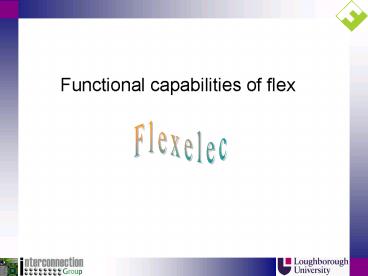Functional capabilities of flex PowerPoint PPT Presentation
1 / 30
Title: Functional capabilities of flex
1
Functional capabilities of flex
Flexelec
2
Futureproofing issues
- 42 V systems
- Digital transmission of data
- Electromagnetic compatibility
3
42 V systems
- No dielectric breakdown at 20kV after 2000 hrs
humidity testing, 2500hrs thermal cycling - FPC layout can be designed to avoid risk of 42 V
line to 12 V line shorting - FPC overcurrent failure mode - adjacent tracks
less likely to short together when insulation
melts than with wire. Inherently safer?
4
Digital Transmission of Data
- Question Can a flexible printed circuit
automotive harness handle the digital
transmission of data? - To answer this look at the physical requirements
of a bus for an Automotive Multiplex Network
5
Automotive Multiplex Networks
- Transmission of digital information between
vehicle modules over a common bus - Reduces the number of point to point wiring
connections - Standards exist to facilitate interoperability
6
SAE Multiplex Network Classifications
7
Controller Area Network (CAN)
- Requirements placed on physical parameters of the
wires of the bus (ISO11898) - Revised question can a cost effective (i.e. reel
to reel) flexible printed circuit harness meet
the requirements for high speed CAN?
8
CAN network topology
9
Electrical parameters of the bus
(ISO11898 Table 13 Physical Media Parameters of a
Pair of Wires)
- Lengthrelated resistance r
- Impedance Z
- Specific line delay
10
Typical sample
- Spacing a
- Nominal 0.5 mm
- Measured 0.56 /- 0.02 mm
11
Length Related Resistance
- For 35?m (1oz) copper 70 mW/m is equivalent to a
7.6mm wide track - A compromise width of 2mm was used for most
samples - This is equivalent to reducing the maximum bus
length to 10.5m
12
Impedance Results
Measured x Field solver
Acceptance region
7.6 mm tracks sample
13
Specific Line Delay
- Specific line delay values less than 5ns/m
- Meets specification
14
Conclusions
- Can large area FPC harnesses produced by a cost
effective process meet the requirements of the
ISO11898 standard? - Yes - but
- Compromise reduced track width of 2mm implies
reducing maximum bus length to 10.5m
15
Electromagnetic Compatibility (EMC)
- Electromagnetic compatibility the ability of
systems and equipment to function - without adversely affecting other equipment
- being adversely affected by other equipment
- Question Is a flexible printed circuit harness
likely to have a better or worse EMC performance
than a wire harness?
16
Why would an FPC harness have a better EMC
performance?
- In a wire harness cant control which wires lie
adjacent in the bundle - causes variability in performance from unit to
unit - In an FPC harness can control which tracks are
adjacent - no variability in performance?
17
Why would an FPC harness have a worse EMC
performance?
- To improve EMC performance of a wire harness
designers can use twisted wire pair or shielded
wire - Do structures with equivalent performance exist
for an FPC?
18
Methodology
- Compare wire and fpc structures in standard EMC
tests
19
Automotive Component Tests
SAE J1113-25 Tri-plate line
20
Cable Tester
21
Samples - wire
- Worst caseSingle unscreened wire - return
through earth - Best caseBMW twisted wire pair, 74?360?
twists per meter
22
Samples - FPC
- Coplanar twin track
- Through hole twisted pair (10 repeats/m)
23
Samples - FPC
- Twisted pair emulator (wiggly track, 139
repeats/m)
24
Samples - FPC
- Shielded coplanar track
No shielding here
25
Results 1-30 MHz
26
Results 20 MHz to 1 GHz
27
Results 1-30 MHz
28
Results 1-30 MHz
29
Ranking of samples
WORST
- Single wire earth return
- Coplanar twin tracks
- Twisted pair emulator
- Twisted wire pair/through hole FPC
- Shielded coplanar twin tracks
BEST
30
Conclusions
- All FPC structures perform better than a single
wire with earth return over the 1-30MHz range - The coplanar tracks and twisted pair emulator are
particularly cost effective methods of gaining
improvement in EMC performance

